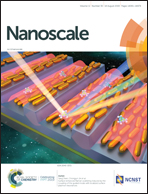Self-assembled carbon nanoparticles as messengers for artificial chemical communication†
Abstract
Herein, supramolecular carbon nanoparticle aggregates were obtained via covalent functionalization of the shell of nanoparticles with triazine and subsequent hydrogen bonding reticulation upon the addition of naphthalene diimide. The resulting reticulated nanoparticles maintained the optical properties required for artificial chemical communication but exhibited a reduced diffusion coefficient, enabling sharper and more intense molecular bit capabilities when employed as chemical messengers. As a result, they are ideal candidates for the transport of information along extended fluid paths. We believe that our results represent a further step towards the understanding and optimization of all the experimental parameters affecting the information transfer efficiency in artificial chemical communication.



 Please wait while we load your content...
Please wait while we load your content...